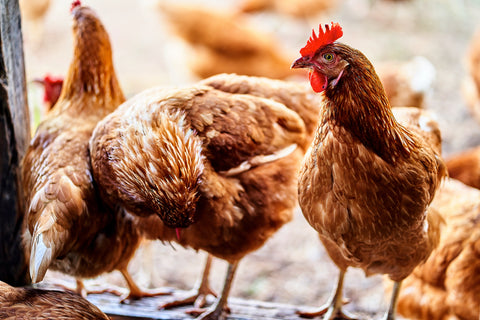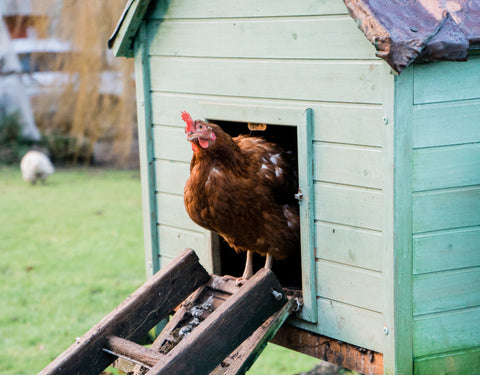The European fox, introduced to Australia in the 1870s, has become one of the most adaptable and successful predators of Australian native wildlife and backyard chickens. Despite being difficult to catch and see, foxes are highly mobile and pose a real threat to pets such as rabbits, guinea pigs, and chickens.
Introduced for the purpose of hunting, it’s not surprising that the fox population has since exploded to a number of around eight million. Weighing between five and seven kilos and with no notable differences between the sexes, the adult fox is one of the top predators to be aware of when protecting Australian native wildlife and backyard chickens.
How foxes move around suburbia
Foxes are highly mobile and are happy to travel relatively large distances in order to get their meal. It’s not unusual for a fox to travel up to 15 kilometres from its den and utilise existing infrastructure such as railway lines and waterways as easy ways to access the city’s suburbs.
Why foxes thrive in the city
Foxes thrive more in the city than on farms and rural areas due to the low risks to their survival and plentiful food sources. There’s an abundance of food for the fox with the huge amount of waste that is produced from cafes and restaurants and of course household waste. It’s often much harder for a fox to safely earn a meal in the country.
Pets such as chickens, rabbits and guinea pigs are also popular meal choices for the fox when keepers don’t have robust enclosures and coops to contain their pets in at night. Other live meals come in the form of rodents, birds and native animals including wallabies, lizards, frogs, and the like.
Foxes are actually omnivorous so can eat plant matter as well as meat but their preference is always meat. They will also stockpile surplus meat by burying it in the ground for when food is less plentiful and eat insects, fruit, and berries when they have to.
Why foxes are so difficult to catch and see
Foxes are primarily nocturnal, although they are becoming increasingly active during the daytime. Part of the reason is the lower risk of them living in the city. They won’t get shot at, baited or trapped within urban areas of a city so they feel a lot less threatened.
They also have plenty of good hiding places such as underneath buildings and bridges, beside waterways, in parks, and on golf courses. Their superior sense of smell and keen powers of observation means that they can usually “outfox” most other animals and humans.
Keeping chickens safe from fox attacks
Keeping chickens safe from foxes is not difficult but does require a good coop set-up and being wary of the fox threat when allowing them to roam outside. You’ll need to pay attention to the signs that a fox is visiting at night to avoid a potential break-in, which include scratching or digging around the coop and being woken by frightened chickens.
A fully enclosed coop with a mesh floor is the simplest way to keep chickens safe but you will need to allow enough space for all the chooks to be happy for extended periods of time such as when you are away on holiday. Of course, your chickens are only safe while they’re inside with the door closed. The most common story that I hear is the one time that the door wasn’t closed and a fox noticed the fact.
If you don’t have a fully enclosed run area for your chickens to roam around in, make sure that mesh at the bottom perimeter is dug-in at least 100mm or extends out 200mm from the perimeter. This will stop foxes from digging under the fence.
To protect your chickens from a climbing fox, as they are adept climbers, it’s a good idea to have a floppy top to the fence so that any climbing fox won’t be able to gain purchase and fall off (on the outside!). Another option for areas with a high density of foxes is electric poultry netting which is moveable and sends a short, sharp shock to any animal that touches it.
Ways to catch foxes
If you know that you have a fox lurking around or have lost chickens to a fox already, it may be time to catch it. Living in urban areas, chicken keepers are limited to the methods they can use for fox control.
The most effective and humane way to catch a fox is by using a cage trap purpose-built to contain a fox. The good thing about a cage trap is that it’s safe and easy to release a non-targeted animal such as your pet cat or dog. I’ve caught a number of our hens in our fox trap but always find an egg inside so they make good use of their short imprisonment.
Luring foxes into your trap
Foxes are extremely smart and can detect the faintest of human smells. The more “earthy” and natural the smell of a trap the better. Fresh chicken pieces or tinned tuna are ideal to use as bait to attract foxes and leaving a trail of “breadcrumbs” for foxes will help lead them into the cage. The way to do this is to place very small amounts of the bait as the “breadcrumbs” or tie a piece of string around a fresh chicken drumstick and drag it from the edge of your property to the front of the trap.
Removing foxes from your property
There are a number of ways that you can remove a fox that you’ve been able to trap. You may even be lucky enough to find a service that will collect and dispose of the fox for you.
The first is to contact your local Council to see if they have a fox removal and disposal service in your area. You might also have a local Vet who can accept foxes for disposal or a local branch of the RSPCA that may be able to help. Lastly, you may have an Animal Shelter or Animal Pound in your area that will dispose of foxes for you.
So, in the end, you can’t completely remove the danger of predators when keeping chickens but you can go a long way in reducing the risks. Most predators are relatively harmless when compared with the fox and you must make certain that your flock is kept as safe as possible from these intelligent and highly skilled killers.







Comments (0)
There are no comments for this article. Be the first one to leave a message!